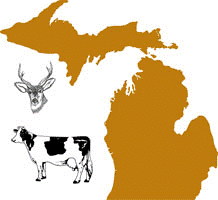Wildlife Disease and Zoonotics

Michigan Bovine Tuberculosis Bibliography and Database
Date of this Version
2003
Abstract
In 1975, a wild white-tailed deer infected with bovine tuberculosis was shot in the northeastern Lower Peninsula, Michigan. The shooting of a second infected deer in the same area in 1994 triggered ongoing disease surveillance in the region. By 2002, bovine tuberculosis had been confirmed in 12 Michigan counties: from 449 deer; two elk; 41 non-cervid wildlife; one captive cervid facility and 28 cattle herds. We analyzed geographic spread of disease since the surveillance began and investigated factors influencing the prevalence of disease within the infected area. These analyses reveal that 78 percent of tuberculous deer came from within a 1560 km2 'core' area, within which the prevalence of apparent disease averaged 2.5 percent. Prevalence declined dramatically outside of the core and was an order of magnitude lower 30 km from its boundary. This prevalence gradient was highly significant (P<0.0001) and did not alter over the 6 year surveillance period (P= 0.98). Within the core, deer density and supplemental feeding by hunters were positively and independently correlated with tuberculosis prevalence in deer. Together, these two factors explained 55 percent of the variation in prevalence. We conclude that bovine tuberculosis was already well established in the deer population in 1994, that the infected area has not expanded significantly since that time, and that deer over-abundance and food supplementation have both contributed to ongoing transmission of disease. Managers are currently enforcing prohibitions on deer feeding in the core and are working to lower deer numbers there through increased hunting pressure.

